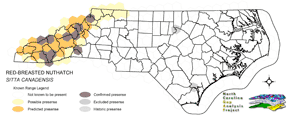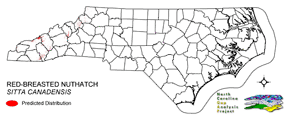
| Taxa: |
| Order: |
| Family: |
| Aves |
| Passeriformes |
| Sittidae |
| NatureServe Global Rank: |
| NatureServe State (NC) Rank: |
| G5 |
| S3B,S4N |
| Federal Status: |
| NC State Status: |
| --- |
| W2,W5 |


| Land Unit |
| US Fish & Wildlife Service |
| US Forest Service |
| US National Park Service |
| US Department of Defense |
| NC State Parks |
| NC University System |
| NC Wildlife Res. Com. |
| NC Forest Service |
| NC Div. of Coastal Mgmt. |
| Local Governments |
| Non-Governmental Org. |
| Other Public Lands |
| Private Lands |
| GAP Status 1-2 |
| All Protected Lands |
| Statewide |
| Hectares |
| 0.00 |
| 10,095.93 |
| 0.00 |
| 14,318.46 |
| 455.13 |
| 3.60 |
| 72.54 |
| 0.39 |
| 0.00 |
| 446.22 |
| 1,117.44 |
| 0.00 |
| 15,635.61 |
| 17,388.66 |
| 26,508.90 |
| 42,145.32 |
| Acres |
| 0.00 |
| 24,947.58 |
| 0.00 |
| 35,381.68 |
| 1,124.65 |
| 8.90 |
| 179.25 |
| 2.89 |
| 0.00 |
| 1,102.63 |
| 2,761.25 |
| 0.00 |
| 38,636.43 |
| 42,970.23 |
| 65,506.83 |
| 104,145.26 |
| % of Dist. on |
| Prot. Lands |
| 0.0 % |
| 38.1 % |
| 0.0 % |
| 54.0 % |
| 1.7 % |
| < 0.1 % |
| 0.3 % |
| < 0.1 % |
| 0.0 % |
| 4.2 % |
| 4.2 % |
| 0.0 % |
| 0.0 % |
| 65.6 % |
| ----- |
| ----- |
| % of Dist. on |
| All Lands |
| 0.0 % |
| 24.0 % |
| 0.0 % |
| 34.0 % |
| 1.1 % |
| < 0.1 % |
| 0.2 % |
| < 0.1 % |
| 0.0 % |
| 1.1 % |
| 2.7 % |
| 0.0 % |
| 37.1 % |
| 41.3 % |
| ----- |
| ----- |
|
Permanent resident of the spruce-fir and hemlock forests of the mountains (Potter et al 1980). Prefers coniferous forest, although Kaufman (1996) lists mixed forests will also be used. Mature forests are selected for (Potter et al 1980, Simpson 1992) probably because old decaying wood present in these forests provides good nesting sites (Kaufman 1996). Limited to habitat above 3500ft. Nest is usually excavated by the breeding pair (Hamel 1992, Kaufman 1996, Potter et al 1980), but will also use natural cavities or old woodpecker holes (Pravosudov and Grubb 1993). Ordinarily the cavity is hollowed out in rotten snag or stub of a living or dead tree generally 5 to 40 above the ground (Kaufman 1996). Pitch is plastered around the opening of the cavity as long as the nest is active, and is thought to be a deterrent to insects and predators entering the nest (Kaufman 1996, Potter et al 1980). Lining of the nest is often soft plant and animal fibers, such as bark fibers, feathers, moss, and soft grass (Kaufman 1996). Insects or larvae picked from the bark on the trunk or branches of evergreen trees, make up their main food source during the breeding season (Hamel 1992). NATURE SERVE GLOBAL HABITAT COMMENTS: Coniferous and mixed forest, aspen woodland; in migration and winter also in deciduous forest, open woodland, parks, scrub, and riparian woodland (AOU 1983). Nests usually in excavated cavity in tree stub or branch of dead tree, or dead top of live tree, also in abandoned woodpecker hole, natural cavity, or bird box; average of 4-5 m above ground. |
| Code | Name | Description | NC Natural Heritage Program Equivalent |
| 521 | Spruce/Fir Forest | High Elevation Frazer-Fir - Red Spruce, Red Spruce and Red-Spruce-Yellow Birch Forests. Tree densities included here include both woodland to forest density. Highly intermixed with Northern Hardwoods, Grassy Balds, and Shrub Balds. | Red Spruce--Fraser Fir Forest, Fraser Fir Forest |
| 527 | Appalachian Hemlock | Upland hemlock forests of the moutains region. Vary from side slopes to steep slope positions. | Canada Hemlock Forest |
| 528 | Appalachian Xeric Pine Forest | Pine forests and woodlands on xeric sites. A variety of pines, including Virginia, Shortleaf, Eastern White Pine, Table Mountain and Pitch pine. Often small areas of dense pine within a matrix of Xeric Oak-Pine Forests. | Pine Oak Heath |
| 529 | Appalachian Xeric Mixed Forest | Mixed forests with Virginia, Shortleaf, Eastern White Pine, Table Mountain and Pitch pines in combination with xeric oak species. Oaks include, white, Southern Red, black, and rock chestnut. | Pine Oak Heath |
|
Bent, A.C. 1948. Life histories of North American nuthatches, wrens, thrashers, and their allies. U.S. National Museum Bulletin 195. Washington, D.C.
Hamel, P. B. 1992. The land manager's guide to the birds of the south. The Nature Conservancy, Chapel Hill, North Carolina. 367 pp + several appendices. Simpson MB Jr. 1992. Birds of the Blue Ridge Mountains. Chapel Hill and London: University of North Carolina Press. Pravosudov, V. V. and T.C. Grubb JR. 1993. White-breasted nuthatch. In Poole A. and Gill F., eds. The birds of North America. No. 54. Kaufman K. 1996. Lives of North American Birds. Boston, New York: Houghton Mifflin Company. Harrison, H.H. 1975. A field guide to bird's nests in the U.S. east of the Mississippi River. Houghton Mifflin Company, Boston, Massachusetts. 257 p. Harrison, C. 1978. A field guide to the nests, eggs and nestlings of North American birds. Collins, Cleveland, Ohio. Harrison, H.H. 1979. A field guide to western birds' nests. Houghton Mifflin Company, Boston. 279 pp. Potter, E. F., J. F. Parnell, and R. P. Teulings. 1980. Birds of the Carolinas. Univ. North Carolina Press, Chapel Hill. 408 pp. Terres, J.K. 1980. The Audubon Society encyclopedia of North American birds. Alfred A. Knopf, New York. American Ornithologists' Union (AOU), Committee on Classification and Nomenclature. 1983. Check-list of North American Birds. Sixth Edition. American Ornithologists' Union, Allen Press, Inc., Lawrence, Kansas. Ehrlich, P.R., D.S. Dobkin, and D. Wheye. 1988. The birder's handbook:a field guide to the natural history of North American birds. Simon and Shuster, Inc., New York. xxx + 785 pp. Mitchell, W.A. 1988. Songbird nest boxes. Section 5.1.8, U.S. Army Corps of Engineers, Wildlife Resources Management Manual. Tech. Rep. EL-88-19. Waterways Experiment Station, Vicksburg, Mississippi. 48 pp. Droege, S., and J.R. Sauer. 1990. North American Breeding Bird Survey, annual summary, 1989. U.S. Fish and Wildlife Service, Biological Report 90(8). 22 pp. |
For more information please contact them at:
NC-GAP Analysis Project
Dept. of Zoology, NCSU
Campus Box 7617
Raleigh, NC 27695-7617
(919) 513-2853
www.basic.ncsu.edu/ncgap